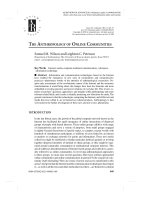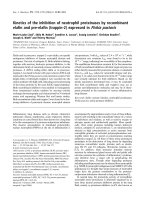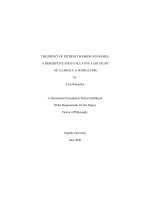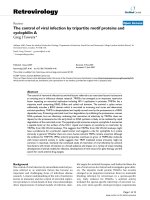The economics of sports 5th by michael a leed and allmen chapter 04
Bạn đang xem bản rút gọn của tài liệu. Xem và tải ngay bản đầy đủ của tài liệu tại đây (2.48 MB, 61 trang )
The Economics of Sports
FIFTH EDITION
Chapter 4
MONOPOLY &
ANTITRUST
MICHAEL A. LEEDS | PETER VON ALLMEN
Introduction
• For most of the twentieth century, professional
leagues in this country operated on the following
two principles:
– Home teams can control their own territory
– Players are bound to their teams as long as their
teams want them
• The first principle reflects the monopolistic market
structure
• The second principle reflects the monopolistic
market structure
• We will study the implications of these structures in
this chapter
Copyright ©2014 Pearson Education, Inc. All rights reserved.
4-2
Learning Objectives
• Identify and illustrate the social costs of monopoly
power
• Analyze how teams apply pricing strategies that result
in increased profits and reduced consumer well-being
• Describe the circumstances under which society may
be better off with a monopoly than perfect competition
• Recognize the importance of entry barriers for
monopoly sports teams and leagues
• Explain Major League Baseball’s exemption from
antitrust laws
• Explain how the NCAA became a cartel
• Apply game theory and the concept of the prisoners’
dilemma
Copyright ©2014 Pearson Education, Inc. All rights reserved.
4-3
4.1 Measuring the Cost of
Monopoly
• We know that
monopolists
$
MC
– Charge more (Pm>Pc)
– Produce less (Qm
• Higher prices
– Hurt consumers
– Help producers
• Is the economy worse
off?
• We need a concept to
measure the harm to
society
Copyright ©2014 Pearson Education, Inc. All rights reserved.
D
Pm
Pc
Qm
Qc
Q
4-4
A Useful Measure: Consumer
Surplus
• Consider four football fans, each of whom are
willing to pay a different price
–
–
–
–
Debbie would pay $40 for a ticket
Bill would pay $20
Jeff would pay $10
Kathleen pays $0
• If the market price is $20
– Bill gets as much happiness as he paid for
• He is the marginal consumer
– Debbie gets $40 worth of happiness for only $20
• She has a $20 (40-20) consumer surplus
Copyright ©2014 Pearson Education, Inc. All rights reserved.
4-5
Consumer Surplus
P
• In general, markets
have many consumers
• Area of triangle shows
consumer surplus:
• Extra happiness for
consumers
• Mathematically:
CS=I(D(Q)dq -PQ
PS=PQ-I(S(Q)dQ
D
Q
Copyright ©2014 Pearson Education, Inc. All rights reserved.
4-6
What’s Wrong with Monopoly?
• In a competitive
market
– Quantity is Qc
– Price is $0
$
MC
A
D
C
Copyright ©2014 Pearson Education, Inc. All rights reserved.
Qc
Q
4-7
What’s Wrong with Monopoly?
• In a competitive
market
– Quantity is E (Qc)
– Price is $0
– Consumer surplus =
ACE
$
MC
A
D
C
Copyright ©2014 Pearson Education, Inc. All rights reserved.
E
Q
4-8
What’s Wrong with Monopoly?
• In a monopoly:
– Quantity is G (QM)
– Price is F
$
A
MC
D
B
F
• Consumer surplus = ABF
• Consumer surplus
shrinks
Copyright ©2014 Pearson Education, Inc. All rights reserved.
C
E
G
Q
MR
4-9
Where Did the Consumer Surplus
Go?
• Some was captured by the producer
– Producer has higher profits
• Given by the area of the rectangle BFCG
• This is a transfer from consumers to producers
• Some is just lost – triangle BGE
– Less is produced and consumed
– A loss that no one gains is a deadweight loss
• In general, fewer games are played than
there would be in perfect competition
Copyright ©2014 Pearson Education, Inc. All rights reserved.
4-10
Other Problems of Monopoly
• Recall James Buchanan: Public Choice School
• Public figures (representatives and bureaucrats)
maximize personal welfare, not public welfare
• Everyone wants to be a monopolist to increase
profit
– If the profit accrues to a factor (resource), we call
it rent
• People lobby for trade restrictions to get rents
– This is called rent seeking
– This is a waste of resources
Copyright ©2014 Pearson Education, Inc. All rights reserved.
4-11
Do Monopolists Always Charge
Monopoly Price?
• The profit maximizing output sets MR=MC
– In our context that means MR=0
– It is not hard to show that this sets price elasticity of
demand = -1
• Studies have shown that teams produce too much
– Operate where MR<0
– Where demand is price inelastic
– Do teams fail to maximize profit?
• Maybe profits do not just come from selling tickets
– Some goods are complements to tickets
– Teams might want more fans so they can sell more
parking passes, concessions, and souvenirs
Copyright ©2014 Pearson Education, Inc. All rights reserved.
4-12
Soccer and Monopoly Power
• British Premier Soccer League is an open league
– Teams can be relegated to a lower league
– Teams can be promoted to a higher league
– North American leagues are closed
• Open leagues have less monopoly power
– They cannot limit the number of teams in a city
– Any team can form in a low league and work its way
up
– In 2012-13, 6 Premier League teams were in London
(Arsenal, Chelsea, Fulham, Queens Park Rangers,
Tottenham Hotspur, and West Ham United)
– Closed Leagues never have that many teams in a city
Copyright ©2014 Pearson Education, Inc. All rights reserved.
4-13
4.2 Strategic Pricing and
Discrimination
• In the basic monopoly model, the monopolist
chooses one price and charges it to all customers at
all times
• In the real world, firms charge different prices for
the same item
– At different times
– For different customers
• Such pricing enhances the monopolist’s profits
• We now expand the basic model to explain these
observations
Copyright ©2014 Pearson Education, Inc. All rights reserved.
4-14
Variable Ticket Pricing
• Some games are more attractive than others
– Example: weekend effect
– These factors are known before the season even
begins
• Variable ticket pricing sets ticket prices in line
with expected demand for a future game
• Teams charge more for more attractive games
– Demand and MR are higher for more popular games
– Firm sets MC equal to different MRs (See Fig. 4.3)
• This has become popular in NHL
Copyright ©2014 Pearson Education, Inc. All rights reserved.
4-15
Dynamic Ticket Pricing
– Some factors that influence demand are not known before
the season opens
• The demand for Mets tickets rises R.A. Dickey pitches
• Dynamic Ticket Pricing allows the team to
capture additional revenue based on individual
game characteristics that are unknown at the start
of the season
• The teams adjust ticket prices during the season as
events unfold
– This has become popular in MLB
Copyright ©2014 Pearson Education, Inc. All rights reserved.
4-16
Bundling
• Some fans want to see specific games very badly
– They are willing to see less attractive games to get
the tickets they want
• Teams bundle less attractive tickets with more
attractive tickets
– To see the Cubs play the White Sox one must also buy
a ticket for the Cubs game against the Pirates
– The fan gets to see the team he wants at a (relatively)
low price
– The team sells tickets that it would not otherwise sell
Copyright ©2014 Pearson Education, Inc. All rights reserved.
4-17
Price Discrimination
• This consists of charging one consumer more than
another for the same product
– Charging different prices of slightly different products
is not price discrimination
• Example: Variable ticket pricing
• Team captures some of the deadweight loss as
profit
• This discrimination is not based on prejudice
– Firms charge more to those willing and able to pay
more
Copyright ©2014 Pearson Education, Inc. All rights reserved.
4-18
Perfect Price Discrimination
• We assume that the firm knows each consumer’s
individual demand
• Recall that four consumers were willing to pay four
different prices
–
–
–
–
Debbie $40
Bill $20
Jeff $10
Kathleen $0
• A perfectly discriminating monopolist (or first-degree
monopolist) turns each consumer into a marginal
consumer
– It charges these prices as long as they exceed MC
Copyright ©2014 Pearson Education, Inc. All rights reserved.
4-19
First Degree Price Discrimination
• Team knows everything
– Consumers’ willingness
and ability to pay
– Each consumer gets 1
unit
– D is market demand
$
MC
• Team produces the
competitive output
– P = MR P = MC
– No deadweight loss
– But the monopolist gets
ALL the consumer
surplus
Copyright ©2014 Pearson Education, Inc. All rights reserved.
D=MR
Qc
Q
4-20
Personal Seat Licenses (PSL)
• Carolina Panthers first used PSLs
– Now many teams widely imitate this practice
– It has become popular in the NFL
• PSLs are a form of two-part pricing
– Fans pay for the right to buy season tickets
• The first part of the price is a fee that represents a
part of the individual fan’s consumer surplus
• The second part is the market price per ticket
• In Figure 4.4, the team knows everything about the
consumer surplus and it sets the market price of
zero (=MC)
Copyright ©2014 Pearson Education, Inc. All rights reserved.
4-21
Figure 4.1
Copyright ©2014 Pearson Education, Inc. All rights reserved.
4-22
Figure 4.2
Copyright ©2014 Pearson Education, Inc. All rights reserved.
4-23
Figure 4.3
Copyright ©2014 Pearson Education, Inc. All rights reserved.
4-24
Figure 4.4
Copyright ©2014 Pearson Education, Inc. All rights reserved.
4-25









